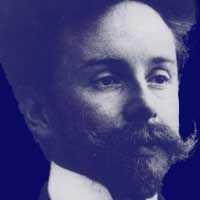Alexander Scriabin - Biography
Alexander Scriabin Biography
Alexander Nikolayevich Scriabin (Алекса́ндр Никола́евич Скря́бин; sometimes transliterated as Skryabin) (January 6, 1872 – April 27, 1915) was a Russian composer and pianist.
| Contents |
Biography
Scriabin was born in Moscow. He studied the piano from an early age, taking lessons with Nikolay Zverev who was teaching Sergei Rachmaninoff at the same time. He later studied at the Moscow Conservatory with Anton Arensky, Sergey Taneyev, and Safonov. He became a noted pianist despite his small hands with a span of barely over an octave (at one point he actually damaged his hand from practicing pieces which required greater hand spans). Scriabin, previously interested in Nietzsche's ubermensch theory, also became interested in theosophy, and both would influence his music and musical thought. In 1909-1910 he lived in Brussels, becoming interested in Delville's Theosophist movement and continuing his reading of Hélène Blavatsky (Samson 1977). Theosophist and composer Dane Rudhyar wrote that Scriabin was 'the one great pioneer of the new music of a reborn Western civilization, the father of the future musician,' (Rudhyar 1926b, 899) and an antidote to 'the Latin reactionaries and their apostle, Stravinsky' and the 'rule-ordained' music of 'Schoenberg's group.' (Ibid., 900-901).
A hypochondriac his entire life, Scriabin died in Moscow from septicemia. For some time before his death he had planned a multi-media work, to be performed in the Himalayas, that would bring about the armageddon, 'a grandiose religious synthesis of all arts which would herald the birth of a new world' (AMG 1 (http://www.allmusic.com/cg/amg.dll?p=amg&token=ADFEAEE47F1DD94AA97F20C393327BD3B17BCD10DF7CFB9811326A5DD3A13C49840138E253F89593E4BD3CEB3BF4B32FA44509CCC8EE56F8906037388CE4A366285E36&sql=41:7982~T1)). This piece, Mysterium, was never realized.
He was related to Vyacheslav Molotov, the Russian politician and eponym of the Molotov cocktail. Molotov's original surname was Scriabin.
Pianists who have performed Scriabin to critical acclaim include Vladimir Sofronitzky and Vladimir Horowitz.
Music
Style and influences
Many of Scriabin's works are written for the piano; the earliest pieces resemble Frederic Chopin and include music in many forms that Chopin himself employed, such as the etude, the prelude and the mazurka. Later works, however, are strikingly original, employing very unusual harmonies and textures. The development of Scriabin's voice or style can be followed in his ten piano sonatas: the earliest are in a fairly conventional late-Romantic idiom and show the influence of Chopin and Franz Liszt, but the later ones move into new territory, the last five being written with no key signature. Many passages in them can be said to be atonal, though from 1903 through 1908, 'tonal unity was almost imperceptibly replaced by harmonic unity.' (Samson 1977) See: mystic chord.
Aaron Copland praised Scriabin's thematic material as 'truly individual, truly inspired', but criticized Scriabin for putting 'this really new body of feeling into the strait-jacket of the old classical sonata-form, recapitulation and all' calling this 'one of the most extraordinary mistakes in all music.' According to Samson the sonata-form of Sonata No. 5 has some meaning to the work's tonal structure, but in Sonata No. 6 and Sonata No. 7 formal tensions are created by the absence of harmonic contrast and 'between the cumulative momentum of the music, usually achieved by textural rather than harmonic means, and the formal constraints of the tripartite mould.' He also argues that the Poem of Ecstasy and Vers la Flamme 'find a much happier co-operation of 'form' and 'content'' and that later Sonatas such as Sonata No. 9 employ a much more flexible sonata-form. (Samson 1977)
Influence of Color
Though these works are often considered to be influenced by Scriabin's synaesthesia, a condition wherein one experiences stimulus in one sense in response to real stimulus in another sense, it is most likely Alexander Scriabin did not actually experience the physiological condition of synaesthesia. His color system, unlike most synaesthetic experience, lines up with the circle of fifths, indicating that it was a thought-out system influenced by his theosophic readings and based on Sir Isaac Newton's Optics. However, this pioneering use of multimedia also was influenced by Scriabin's theosophical beliefs; specifically, he thought he could bring about the end and rebirth of the world through a grand performance including music, scent, dance, and light that would take place in the Himalayas.
Scriabin wrote only a small number of orchestral works, including a piano concerto (1896), The Poem of Ecstasy (1908) and Prometheus: The Poem of Fire (1910), which includes a part for a 'clavier à lumières' - an implement played like a piano, but which flooded the concert hall with coloured light rather than sound. Few performances of the piece, including the premiere, have included this light element, although a performance in New York City in 1915 projected colours onto a screen.
See also
External links
- Scriabin Society of America (http://www.scriabinsociety.com/)
- The mythical time in Scriabin (http://users.unimi.it/~gpiana/dm4/dm4scrlt.htm) by Lia Tomás
- Was Scriabin a Synaesthete? (http://prometheus.kai.ru/skriab_e.htm) by B. Galeyev & I. Vanechkina
- Scriabin in Aspen No.2 on UBUWEB (http://www.ubu.com/aspen/aspen2/scriabin.html) (A short biography by Faubion Bowers; four preludes and the tenth sonata available for download)
- ChopinMusic - Scriabin (http://www.chopinmusic.net/forum/composer.php?c=scriabin) (Scriabin - Biography, Links, Discussion, Recordings, etc.)
- Piano Society.com - Scriabin (http://www.pianosociety.com/index.php?id=25) (A short biography and description of the piano sonatas by Koji Attwood; various free recordings available for download.)
- Scriabin's Sheet Music (http://www.mutopiaproject.org/cgibin/make-table.cgi?Composer=ScriabinA&preview=1) by Mutopia Project
References
- Samson, Jim (1977). Music in Transition: A Study of Tonal Expansion and Atonality, 1900-1920. New York: W.W. Norton & Company. ISBN 0393021939.
- Dane Rudhyar's Vision of American Dissonance (http://articles.findarticles.com/p/articles/mi_m2298/is_2_17/ai_61551810) American Music, Summer, 1999 by Carol J. Oja
- Rudhyar (1926b).
This biography is published under the GNU Licence

